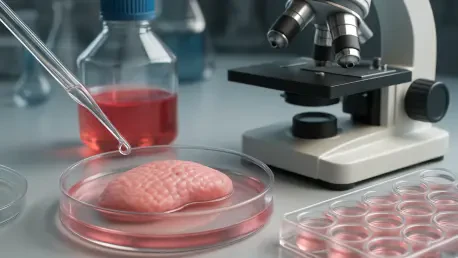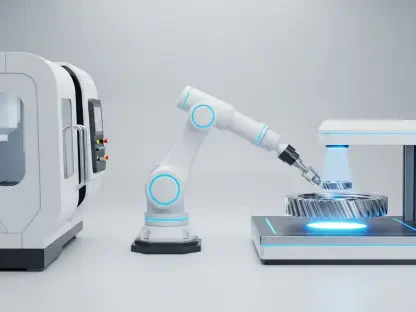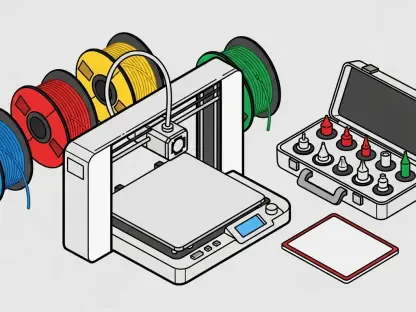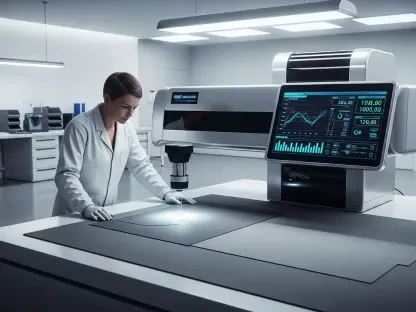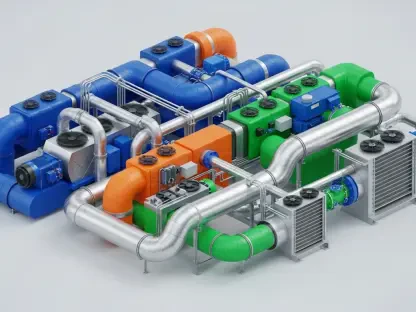In a world where organ shortages and chronic diseases continue to challenge healthcare systems globally, 3D Systems, a titan in additive manufacturing, is stepping up with groundbreaking solutions in regenerative medicine. This innovative field, which focuses on creating living tissues and organs through advanced bioprinting techniques, holds the promise of transforming patient care by addressing some of the most pressing medical needs. Based in Rock Hill, South Carolina, 3D Systems has strategically realigned its leadership and resources to drive this ambitious vision forward, positioning itself as a leader in a sector poised for explosive growth. Beyond healthcare, the company is also tapping into immediate market opportunities in industries like aerospace, balancing long-term aspirations with tangible financial gains. This article delves into how 3D Systems is navigating the complex interplay of technology, finance, and market dynamics to redefine the boundaries of medicine and manufacturing.
Shaping the Future Through Leadership
In a bold move to prioritize high-growth sectors, 3D Systems has restructured its executive team, establishing a dedicated President of Regenerative Medicine role to lead its bioprinting initiatives. This strategic shift underscores a commitment to tackling monumental healthcare challenges, such as developing 3D-printed organs for transplantation. By aligning its leadership with a clear focus on innovation, the company aims to streamline efforts and channel expertise into creating solutions that could one day eliminate organ waiting lists. This restructuring also extends to operational efficiency, with a goal to reduce operating costs significantly by mid-2026, ensuring that resources are directed toward transformative projects. The emphasis on specialized roles reflects an understanding that pioneering in uncharted territories like regenerative medicine requires not just technological prowess but also visionary guidance to navigate the intricate landscape of research and market demands.
Complementing this leadership overhaul, 3D Systems has appointed key figures to oversee broader commercial strategies across its industrial and healthcare divisions. The elevation of seasoned executives to roles like Chief Commercial Officer signals an intent to unify operations and drive growth in multiple verticals simultaneously. This approach is particularly crucial as the company balances the high-risk, high-reward nature of bioprinting with more immediate revenue streams from other sectors. The leadership’s focus on cost discipline and strategic alignment aims to create a sustainable framework where innovation can thrive without compromising financial stability. By fostering a culture of efficiency and forward-thinking, 3D Systems is laying the groundwork to not only lead in regenerative medicine but also maintain competitiveness in a rapidly evolving additive manufacturing industry.
Breaking Ground in Bioprinting Innovations
At the core of 3D Systems’ transformative agenda lies its pioneering work in bioprinting, a technology with the potential to revolutionize healthcare by producing functional human tissues and organs. Early achievements, such as securing funding for pre-clinical studies on 3D-printed lungs and obtaining FDA clearance for dental printing solutions, highlight the company’s progress in this cutting-edge field. These milestones, while promising, are just the beginning of a long journey toward widespread clinical application. The ability to print viable organs could address critical shortages, offering hope to millions awaiting transplants. However, the complexity of replicating living tissues with precision demands relentless innovation and patience, as the technology must meet stringent safety and efficacy standards before it can reach patients on a global scale.
Despite these advancements, the path to commercialization in regenerative medicine remains challenging for 3D Systems due to significant regulatory and technical barriers. The process of gaining approvals from health authorities involves navigating a maze of clinical trials and compliance requirements, which can span years and consume substantial resources. Additionally, the high costs associated with research and development pose a financial burden, especially as outcomes remain uncertain in the short term. While the vision of printing organs like lungs for transplantation captures the imagination, turning this into a practical reality requires overcoming hurdles in material science and bioengineering. For 3D Systems, success in this arena will depend on sustained investment and strategic partnerships that can accelerate progress while mitigating risks inherent in such a groundbreaking endeavor.
Fueling Growth with Aerospace Advancements
While regenerative medicine represents a long-term vision, 3D Systems is achieving remarkable success in the aerospace and defense sector, providing a vital financial foundation. Leveraging its Direct Metal Printing technology, the company has secured contracts to produce essential spacecraft components, resulting in an impressive 84% revenue increase in this segment during Q2 of the current year. This growth aligns with broader trends favoring localized manufacturing, driven by governmental pushes to secure supply chains and reduce dependency on foreign production. The ability to deliver lightweight, high-precision parts positions 3D Systems as a key player in an industry hungry for innovative solutions. This immediate revenue stream offers a counterbalance to the extended timelines associated with bioprinting, allowing the company to fund ambitious research while maintaining market relevance.
The aerospace sector’s growth is not just a financial win but also a testament to 3D Systems’ technological versatility and adaptability to market needs. With a projected market for thermal management solutions expected to reach $4 billion by 2030, the company is well-placed to capitalize on increasing demand for advanced manufacturing in space exploration and defense applications. Partnerships with major industry players further strengthen its foothold, ensuring a steady flow of projects that test and refine its additive manufacturing capabilities. This success in aerospace serves as a proving ground for technologies that could eventually cross over into healthcare applications, demonstrating the interconnectedness of 3D Systems’ diverse portfolio. By excelling in this high-demand area, the company builds credibility and resources critical for sustaining its longer-term goals in regenerative medicine.
Strengthening Finances for Sustained Innovation
To support its bold ventures into uncharted territories, 3D Systems has executed strategic financial maneuvers, including the divestiture of non-core assets like a software platform for a substantial sum. This move has bolstered the balance sheet, enabling significant debt reduction and a reduction in operating expenses, which translated into a notable profit turnaround in the current year despite a decline in overall revenue. Such financial discipline is essential for freeing up capital to invest in research-intensive projects like bioprinting, where returns may not materialize for years. The ability to achieve net income in a challenging economic climate reflects a pragmatic approach to balancing innovation with fiscal responsibility, though lingering uncertainties around customer capital spending continue to pose potential risks.
Beyond asset sales, 3D Systems is targeting operational efficiencies with a clear plan to slash costs over the next couple of years, aiming for a leaner structure that prioritizes high-impact initiatives. This focus on streamlining operations ensures that resources are allocated to areas with the greatest potential for growth, such as regenerative medicine and aerospace. However, the lack of full-year financial guidance suggests a cautious outlook, tempered by global economic headwinds and trade policy fluctuations that could impact performance. For stakeholders, the improved profitability is a positive sign, yet it comes with the caveat that sustained investment in cutting-edge technologies requires a delicate balance. The financial health achieved through these measures provides a buffer, allowing 3D Systems to weather short-term volatility while pursuing transformative advancements in healthcare and beyond.
Navigating Challenges and Seizing Opportunities
As 3D Systems forges ahead in both regenerative medicine and aerospace, it must contend with a range of industry-wide challenges that could influence its trajectory. Global trade barriers, fluctuating tariffs, and hesitancy in customer capital spending present ongoing uncertainties that could disrupt growth plans. Additionally, the regulatory landscape for bioprinting remains a formidable obstacle, with long approval processes and technical complexities delaying market entry for revolutionary therapies. Balancing these risks requires meticulous execution and a keen eye on cost control to ensure that resources are not stretched too thin. The company’s ability to adapt to these external pressures while maintaining a focus on innovation will be a defining factor in its long-term success across diverse sectors.
On the flip side, 3D Systems is actively pursuing diverse opportunities to expand its market presence, exemplified by innovations like advanced polymer printers and strategic collaborations in transportation. These initiatives demonstrate a commitment to penetrating new verticals, from electrical components to spare parts production, broadening the company’s revenue base. Such diversification is critical in an industry where technological advancements must be matched by market adoption to achieve lasting impact. While the potential of bioprinting captures headlines, these parallel efforts in other areas provide a safety net, ensuring that the company is not overly reliant on a single sector. By weaving together immediate wins with visionary projects, 3D Systems is crafting a resilient strategy to thrive amid uncertainty, setting a benchmark for others in additive manufacturing.
Reflecting on a Transformative Path
Looking back, 3D Systems made significant strides with a strategic overhaul that redefined its focus on high-growth areas like regenerative medicine and aerospace. The establishment of specialized leadership roles and the pursuit of bioprinting breakthroughs showcased a dedication to solving some of humanity’s most pressing health challenges. Meanwhile, robust growth in aerospace contracts provided the financial stability needed to support these ambitious endeavors. Financial turnarounds through asset sales and cost reductions further strengthened the company’s position, even as revenue challenges persisted. For the future, attention must turn to achieving key milestones in bioprinting, meeting cost-saving targets by mid-2026, and expanding market adoption across industries. Monitoring revenue trends in aerospace and progress in regulatory approvals for medical innovations will be crucial indicators of sustained success, offering a roadmap for stakeholders to assess the company’s evolving impact.
